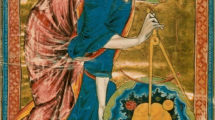Abstract
This paper presents and discusses examples of works of art which, if included in science curricula, could prompt an understanding by students of some concepts in optics through a discussion of the context in which they were created. Such discussion would elucidate the meaning of the artworks and, at the same time, challenge students’ misconceptions, attracting their attention to the scientific aspects of the art works concerned. This type of learning represents a culturally rich approach to modern science curricula. The simplified contrasting of science and humanities is criticized.
Similar content being viewed by others
References
Alonso M., Finn E.J. (1968). University Physics. Addison-Wesley, Reading MA, Vol. 3, pp. 403–411
Bendall S., Goldberg F., Galili I. (1993). ‘Prospective Elementary Teachers’ Prior Knowledge about Light’. Journal of Research in Science Teaching 30(9): 1169–1187
Chapin, J. (ed.): 1957, A Treasury of Catholic Reading, Farrar, Straus & Cudahy, New York
Cohen M.R., Drabkin I.E. (1966). A Source Book in Greek Science. Harvard University Press, Cambridge, MA
Crombie A.C.(1959). Medieval and Early Modern Science. Anchor/Doubleday, New York
Dreyfus A., Jungwirth E., Eliovitch R. (1990). ‘Applying the “Cognitive Conflict” Strategy for Conceptual Change – Some Implications, Difficulties, and Problems’. Science Education 74: 555–569
Ernst B. (1978). Der Zauberspiegel des M.S. Escher. Verlag Heinz Moos, Munchen
Ferguson G. (1961). Signs and Symbols in Christian Art. Oxford University Press, London
Frege G. (1892/1966). ‘On Concept and Object’. In: Geach P., Black M. (eds), Translations from Philosophical Writings of Gottlob Frege. Oxford University Press, Oxford, pp. 42
Galili I., Goldberg F. (1993). “Left–Right Conversions in a Plane Mirror”. The Physics Teacher 31 (8): 463–466
Galili I., Hazan A. (2000a). ‘Learners’ Knowledge in Optics: Interpretation, Structure, and Analysis’. International Journal in Science Education 22(1): 57–88
Galili I., Hazan A. (2000b). ‘The Influence of a Historically Oriented Course on Students’ Content Knowledge in Optics Evaluated by Means of Facets - Schemes Analysis’. American Journal of Physics 68(7): S3–S15
Galili I., Hazan A. (2001a). ‘Experts’ Views on Using History and Philosophy of Science in the Practice of Physics Instruction’. Science & Education 10(4): 345–367
Galili I., Hazan A. (2001b). ‘The Effect of a History-Based Course in Optics on Students’ Views about Science’. Science & Education 10(1–2): 7–32
Galili, I. & Hazan, A.: 2004, Optics – the Theory of Light and Vision in the Broad Cultural Approach, Textbook for high school, Science Teaching Center, The Hebrew University of Jerusalem, Israel
Galili I., Goldberg F., Bendall S. (1991). Some Reflections on Plane mirrors and Images. The Physics Teacher 29(7): 471–477
Galili I., Goldberg F., Bendall S. (1993). ‘Effects of Prior Knowledge and Instruction on Understanding Image Formation’. Journal of Research in Science Teaching 30(3): 271–303
Hewson, P. W., Beeth, M. E. & Thorley, N. R.: 1998, ‘Teaching for Conceptual Change’, in B. J. Fraser & K. G. Tobin (eds.), International Handbook of Science Education, Kluwer Academic Publishers, pp. 199–218.
Langer J. (1988). ‘A Note on the Comparative Psychology of Mental Development’. In: Strauss S. (ed), Ontogeny, Phylogeny & Historical Development. Ablex, Norwood, NJ, pp. 68–85
Lawler R. (1995). Sacred Geometry. Philosophy and Practice. Thames & Hundson, London
Lindberg D.C. (1976). Theories of Vision from Al-Kindi to Kepler. The University of Chicago Press, Chicago, IL
McCloskey M. (1983). “Intuitive physics”. Scientific American 248(4): 122–130
McCloskey, M., Kargon R. (1988). ‘The Meaning and Use of Historical Models in the Study of Intuitive Physics’. In: Strauss S. (eds), Ontogeny, Phylogeny and Historical Development. Ablex, Norwood, NJ, pp. 49–67
Niedderer, H. & Goldberg, F.: 1996, ‘Learning Processes in Electric Circuits’, Paper presented at NARST conference, St. Louis MO, USA. http://www.physik.uni-bremen.de/physics.education/niedderer/personal.pages/niedderer/pubs_files/1996_NARST_LS.pdf
North W. (1995). Handbook of Semiotics. Indiana University Press, Bloomington, IN
Park D. (1997). The Fire within the Eye. Princeton University Press, Princeton, NJ, pp. 126–136
Piaget J. (1970). Genetic Epistemology. Columbia University Press, New York
Piaget J. (1974). Biology and Knowledge. The University of Chicago Press, Chicago
Piaget, J.: 1985, The Equilibrium of Cognitive Structures, University of Chicago Press, Chicago, p. 10
Ronen M., Eylon B.-S. (1993). ‘To See or Not to See: the Eye in Geometrical Optics – When and How? Physics Education 28: 52–59
Schiller G. (1971). Iconography of Christian Art, New York Graphic Society. Greenwich, Connecticut
Shlain L. (1991). Art and Physics. William Morrow, New York, p. 16
Snow C.P. (1961). Two Cultures and the Scientific Revolution. Cambridge University Press, New York
Steadman P. (2002). Vermeer’s Camera. Oxford University Press, London
Tseitlin, M. & Galili, I.: 2006, ‘Science Teaching: What Does it Mean?’, Science & Education 15(5), 393–417
Tseitlin M., Galili I. (2005b). ‘Teaching Physics in Looking for its Self: from a Physics-Discipline to a Physics-Culture’. Science and Education 14(3–5): 235–261
Wind G.D. (2002). Correggio. Hero of the Dome. Silvana Editoriale, Milano
Wiser M. (1988). ‘The Differentiation of Heat and Temperature: History of science and Novice – Expert Shift Use of Historical Models in the Study of Intuitive Physics’. In: Strauss S. (eds), Ontogeny, Phylogeny and Historical Development. Ablex, Norwood, NJ, pp. 29–48
Author information
Authors and Affiliations
Corresponding author
Rights and permissions
About this article
Cite this article
Galili, I., Zinn, B. Physics and Art – A Cultural Symbiosis in Physics Education. Sci Educ 16, 441–460 (2007). https://doi.org/10.1007/s11191-006-9006-1
Received:
Accepted:
Published:
Issue Date:
DOI: https://doi.org/10.1007/s11191-006-9006-1




